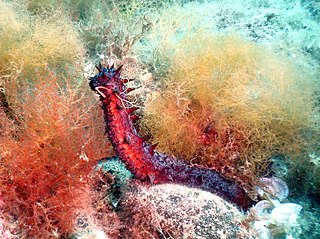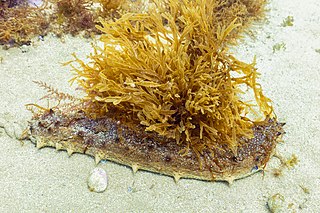
Sea cucumbers are echinoderms from the class Holothuroidea. They are marine animals with a leathery skin and an elongated body containing a single, branched gonad. They are found on the sea floor worldwide. The number of known holothurian species worldwide is about 1,786, with the greatest number being in the Asia-Pacific region. Many of these are gathered for human consumption and some species are cultivated in aquaculture systems. The harvested product is variously referred to as trepang, namako, bêche-de-mer, or balate. Sea cucumbers serve a useful role in the marine ecosystem as they help recycle nutrients, breaking down detritus and other organic matter, after which bacteria can continue the decomposition process.

Isostichopus badionotus, also known as the chocolate chip cucumber or the cookie dough sea cucumber, is a species of sea cucumber in the family Stichopodidae. This common species is found in warm parts of the Atlantic Ocean.

Sea cucumbers are marine animals of the class Holothuroidea. They can be used as food, in fresh or dried form, in various cuisines. In some cultural contexts the sea cucumber is thought to have medicinal value.

Isostichopus fuscus, commonly known as the brown sea cucumber, is a species of sea cucumber in the family Stichopodidae native to the eastern Pacific. It was first described to science by German biologist Hubert Ludwig in 1875.

Holothuria atra, commonly known as the black sea cucumber or lollyfish, is a species of marine invertebrate in the family Holothuriidae. It was placed in the subgenus Halodeima by Pearson in 1914, making its full scientific name Holothuria (Halodeima) atra. It is the type species of the subgenus.

Australostichopus is a genus of sea cucumbers in the family Stichopodidae. It is monotypic, being represented by the single species Australostichopus mollis, commonly known as the brown sea cucumber or Australasian sea cucumber. This species has stimulated interest for its fishery potential in the Southern Hemisphere, and for its capability to reduce waste produced by aquaculture. Despite its ecological role and abundance in New Zealand coastal waters, the scarcity of knowledge regarding A. mollis biology and ecology has hindered the development of a stable fishery industry. Importantly, A. mollis represents promising business potential within an important Asian market. Recently its potential as a functional food has been evaluated, highlighting the nutritious components

Holothuria scabra, or sandfish, is a species of sea cucumber in the family Holothuriidae. It was placed in the subgenus Metriatyla by Rowe in 1969 and is the type species of the subgenus. Sandfish are harvested and processed into "beche-de-mer" and eaten in China and other Pacific coastal communities.

Sea cucumber stocks have been overexploited in the wild, resulting in incentives to grow them by aquaculture. Aquaculture means the sea cucumbers are farmed in contained areas where they can be cultured in a controlled manner. In China, sea cucumbers are cultured, along with prawns and some fish species, in integrated multi-trophic systems. In these systems, the sea cucumbers feed on the waste and feces from the other species. In this manner, what would otherwise be polluting byproducts from the culture of the other species become a valuable resource that is turned into a marketable product.

Holothuria tubulosa, the cotton-spinner or tubular sea cucumber, is a species of sea cucumber in the family Holothuriidae. It is the type species of the genus Holothuria and is placed in the subgenus Holothuria, making its full name Holothuria (Holothuria) tubulosa.
Holothuria spinifera, the brown sandfish, is a species of sea cucumber in the family Holothuriidae. It is placed in the subgenus Theelothuria, making its full name Holothuria (Theelothuria) spinifera. In India it is known as cheena attai or raja attai. It lives in tropical regions of the west Indo-Pacific Ocean at depths ranging from 32 to 60 metres. It is fished commercially to produce beche-de-mer.

Stichopus is a genus of sea cucumbers from the family Stichopodidae.
Chantal Conand is a French marine biologist and oceanographer.

Actinopyga lecanora, commonly known as the white-bottomed sea cucumber or stonefish, is a species of sea cucumber in the family Holothuriidae. It is native to the tropical Western Indo-Pacific region and is harvested for food.
Holothuria grisea, the gray sea cucumber, is a mid-sized coastal species of sea cucumber found in shallow tropical waters of the Atlantic Ocean from Florida to Southern Brazil and West Africa. They have a variety in color and can range from red to more yellowish with brown markings. They are also a food source for local and international markets with the majority of harvesting taking place in Brazil. This species is currently not over-fished and is not endangered or threatened.

Holothuria arguinensis is a species of sea cucumber in the family Holothuriidae and subgenus Roweothuria. It is found in waters off the northeast Atlantic Ocean and Mediterranean Sea. According to some scholarly research, the species is actively expanding its range and colonizing the south-eastern coast of Spain.

Holothuria (Microthele) nobilis, the black teatfish, is a species of sea cucumber in the genus Holothuria. The cucumber is found in the tropical waters of the Indo-pacific ocean. It was first described by Emil Selenka in 1867.
Holothuria lessoni, the golden sandfish, is a species of sea cucumber in the genus Holothuria, subgenus Metriatyla. This sea cucumber inhabits the shallow waters of the Indo-Pacific Ocean, where it is found near islands and reef flats. It is highly sought after in commercial and subsistence fishing and the species threatened by overfishing.

Holothuria (Platyperona) difficilis is a species of sea cucumber in the family Holothuriidae. Holothuria comes from Latin but is originally taken from Greek. Its meaning is a plantlike animal whose origin is uncertain.
Holothuria (Cystipus) cubana is a species of sea cucumber in the family Holothuriidae. This species was first described by Ludwig in 1875.
Holothuria (Selenkothuria) glaberrima, also known as the brown rock sea cucumber, is a species of sea cucumber in the genus Holothuria, subgenus Selenkothuria. The cucumber is distributed in the Western Atlantic Ocean, the Caribbean Sea, and the Gulf of Mexico. The species is found at a depth of 0–42 meters.
















